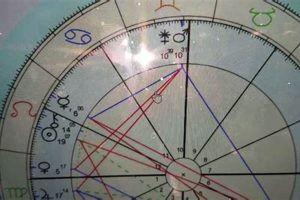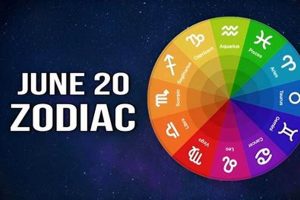In astrological practice, a tool exists to determine the placement of Juno, an asteroid representing commitment, marriage, and long-term partnerships, in a birth chart. This placement, calculated based on the date, time, and location of birth, provides insights into an individual’s approach to relationships, the qualities they seek in a partner, and the dynamics they tend to attract. For example, Juno in Libra might suggest a desire for balance and harmony in partnerships.
Understanding this celestial body’s influence can offer valuable self-awareness concerning relationship patterns and compatibility. By examining its position within the birth chart, individuals can gain a deeper comprehension of their needs and desires within committed relationships, ultimately fostering more fulfilling connections. This practice builds upon ancient observations of celestial bodies and their perceived influence on human behavior, adding another layer of understanding to the complexities of human interaction.
This exploration delves further into the interpretations of Juno’s placement in various astrological signs and houses, offering a comprehensive guide to understanding its significance in individual birth charts.
Tips for Utilizing Juno’s Placement
Interpreting Juno’s placement within a birth chart can provide valuable insights into relationship dynamics. The following tips offer guidance on maximizing the benefits of this astrological tool.
Tip 1: Consider the Sign: Juno’s zodiac sign reveals the qualities one seeks in a partner and the style of relating. Juno in Aries, for instance, suggests a desire for independence and passion, while Juno in Cancer indicates a need for emotional security and nurturing.
Tip 2: Examine the House: The astrological house where Juno resides signifies the area of life where committed partnerships are most significant. Juno in the 7th house, the house of partnerships, emphasizes the importance of one-on-one relationships, while Juno in the 10th house might suggest a focus on career partnerships or public image within relationships.
Tip 3: Explore Aspects: Planetary aspects to Juno can further refine its interpretation. A harmonious aspect from Venus might indicate ease and joy in relationships, whereas a challenging aspect from Saturn could suggest limitations or karmic lessons within partnerships.
Tip 4: Compare with Partner’s Charts: Comparing Juno placements in synastry, the comparison of two birth charts, can illuminate relationship dynamics and potential areas of compatibility or conflict.
Tip 5: Don’t Isolate Juno: Juno is just one piece of the astrological puzzle. Consider its placement in conjunction with other planetary influences for a holistic understanding of relationship patterns.
Tip 6: Use Insights for Growth: Understanding Juno’s influence can facilitate personal growth and improve relationship dynamics. Recognizing one’s needs and patterns allows for more conscious choices and healthier interactions.
By integrating these insights, individuals can gain a deeper understanding of their relationship patterns and cultivate more fulfilling partnerships. This understanding empowers individuals to navigate relationships with greater awareness and intention.
This exploration concludes with a summary of key takeaways and a discussion of further resources for continued learning about astrological influences on relationships.
1. Birth Chart Calculation
Determining Juno’s astrological influence necessitates accurate birth chart calculation. A birth chart acts as a celestial snapshot, mapping the positions of planets and asteroids at the precise moment of birth. This information is fundamental to understanding Juno’s role in an individual’s life, particularly concerning relationships and commitment.
- Birth Data Accuracy
Precise birth datadate, time, and locationis crucial for accurate chart calculation. Minor discrepancies can significantly alter planetary placements, impacting the interpretation. For instance, a slight time difference could shift Juno from one astrological house to another, changing the area of life most influenced by its energy. This precision underscores the importance of reliable birth records when utilizing astrological tools.
- House Systems
Various astrological house systems exist, each employing different methods for dividing the celestial sphere. The chosen system influences the delineation of Juno’s placement within the birth chart. For example, Placidus, Koch, and Equal House systems may yield slightly different house placements for Juno, potentially leading to nuanced interpretations of its influence. Understanding the chosen house system provides context for the analysis.
- Planetary Positions
Birth chart calculation maps the precise positions of all planets, including Juno, at the time of birth. These positions are expressed in degrees within specific zodiac signs. Juno at 15 degrees of Taurus, for example, carries different implications than Juno at 2 degrees of Gemini. These degrees further refine the interpretation of Juno’s energy within the individual’s chart.
- Juno’s Aspects
The calculated birth chart reveals the angular relationships, or aspects, between Juno and other planets. These aspects, such as conjunctions, squares, or trines, color the expression of Juno’s energy. A trine from Venus to Juno, for instance, might signify harmony in relationships, while a square from Saturn could indicate challenges or restrictions. These nuances add depth to the interpretation of Juno’s influence.
A precisely calculated birth chart, incorporating accurate birth data, a chosen house system, precise planetary positions, and aspects, forms the foundation for understanding Juno’s influence in an individual’s life. This foundation enables informed interpretations of relationship patterns and provides a framework for exploring compatibility with others through synastry, the comparison of two birth charts.
2. Juno's Position
An “astrology Juno calculator” serves as the primary tool for determining Juno’s placement within an individual’s birth chart. This placement, expressed in terms of zodiac sign and astrological house, forms the basis for understanding Juno’s influence on relationship patterns and commitment styles. The calculator’s function hinges on accurate birth datadate, time, and locationto generate a precise celestial map. For example, an individual born with Juno in Libra might seek balance and harmony in partnerships, while Juno in the 7th house emphasizes the overall importance of committed relationships in their life. Without the calculator’s precise calculations, determining this crucial information remains elusive.
The significance of Juno’s position extends beyond mere placement. Aspectsangular relationshipsbetween Juno and other planets further refine the interpretation. A conjunction between Juno and Venus, for example, might suggest a tendency towards romantic and aesthetically pleasing partnerships. Conversely, a square between Juno and Saturn could indicate challenges or delays in finding lasting commitment. Understanding these nuances relies heavily on the calculator’s ability to map these complex planetary relationships. Furthermore, comparing Juno’s position in two individuals’ charts (synastry) offers valuable insights into relationship compatibility. The calculator thus facilitates a deeper understanding of interpersonal dynamics.
In essence, Juno’s position, revealed through an “astrology Juno calculator,” acts as a key to understanding relationship predispositions. This understanding fosters self-awareness and informs relationship choices. Challenges in obtaining accurate birth data can hinder the calculator’s precision, impacting the interpretation’s reliability. However, when utilized effectively, the tool provides invaluable insights, empowering individuals to navigate relationships with greater awareness and intention. This knowledge contributes significantly to building and maintaining more fulfilling, conscious partnerships.
3. Relationship Dynamics
Understanding relationship dynamics benefits significantly from utilizing an astrology Juno calculator. This tool reveals Juno’s placement in a birth chart, offering insights into an individual’s approach to commitment, partnership needs, and potential recurring relationship patterns. For example, Juno in Scorpio might suggest intense, transformative partnerships, while Juno in Aquarius could indicate a preference for unconventional or independent relationships. Analyzing Juno’s aspects to other planets adds further nuance. A challenging aspect to Mars, for instance, could indicate conflict or power struggles within relationships, whereas a harmonious aspect to Venus might suggest ease and enjoyment in partnerships. This understanding of individual predispositions provides a foundation for navigating relationship dynamics more effectively.
Comparing Juno placements between partners (synastry) offers further insight into relationship dynamics. For instance, if one partner has Juno conjunct the other’s Venus, there may be a strong sense of attraction and value placed on the relationship. However, if Juno squares Saturn in the composite chart (a chart representing the relationship itself), challenges and limitations may arise. Recognizing these potential dynamics allows for proactive addressal of challenges and fosters greater understanding between partners. Moreover, Juno’s placement can illuminate areas where compromise and understanding are crucial, particularly in cases of seemingly incompatible placements. Real-life examples abound where understanding Juno’s influence has fostered greater empathy and communication within relationships.
In conclusion, the astrology Juno calculator provides valuable insights into relationship dynamics by revealing individual predispositions and potential interaction patterns. This knowledge empowers individuals to navigate relationships with greater awareness. While astrological insights offer guidance, relationship success hinges on conscious effort and communication. Integrating this understanding with other relationship tools and practices enhances the potential for building and sustaining fulfilling partnerships. This information does not determine relationship outcomes but rather offers a framework for understanding and navigating the complexities of human connection.
4. Synastry Compatibility
Synastry, the comparison of two astrological birth charts, offers valuable insights into relationship compatibility. An astrology Juno calculator plays a crucial role in this process by providing the precise placement of Juno in each individual’s chart. This information illuminates how each person approaches commitment, their needs within partnerships, and potential areas of harmony or conflict.
- Juno Conjunctions
When Juno in one person’s chart forms a conjunction with a personal planet (Sun, Moon, Mercury, Venus, Mars) in another’s chart, it often indicates a strong attraction and shared values. For example, Juno conjunct Venus can create a romantic and harmonious connection, while Juno conjunct Mars might suggest a passionate, but potentially competitive, dynamic. These conjunctions, identified through the use of a Juno calculator, highlight key areas of connection within the relationship.
- Juno Aspects to Saturn
Juno’s aspects to Saturn in synastry can reveal potential challenges or limitations within a relationship. A square or opposition between Juno and Saturn might suggest difficulties with commitment, delays in marriage, or feelings of restriction. Understanding these aspects can help couples navigate these challenges with awareness and address potential power imbalances. The Juno calculator provides the necessary information to identify and interpret these crucial aspects.
- Juno in the Same Sign
When two individuals share the same Juno sign, they often have similar values and expectations regarding commitment and partnership. This shared understanding can create a strong foundation for a long-term relationship. For example, two people with Juno in Taurus might prioritize stability and security in their partnership. A Juno calculator allows for quick identification of such shared placements, highlighting potential areas of compatibility.
- Juno in Partner’s Houses
Juno’s placement in a partner’s astrological house can reveal the area of life where that person feels most committed to the relationship. For instance, Juno falling in a partner’s 4th house might indicate a strong emphasis on home and family life within the partnership. The Juno calculator is essential for determining these house overlays, offering valuable insight into the dynamics of the relationship.
Utilizing an astrology Juno calculator in synastry provides a nuanced understanding of relationship compatibility. By examining Juno’s interactions within the compared charts, individuals gain valuable insights into potential strengths, challenges, and areas of growth within the partnership. While Juno offers crucial information regarding commitment and long-term potential, it’s essential to consider other astrological factors for a comprehensive understanding of relationship dynamics. Integrating these insights with open communication and mutual understanding strengthens the foundation for a fulfilling and lasting connection.
5. Self-Awareness
Utilizing an astrology Juno calculator fosters self-awareness regarding relationship patterns and predispositions. Calculating Juno’s placement within a birth chart provides insight into an individual’s needs and desires within committed partnerships. This understanding allows for recognition of recurring themes and potential challenges. For example, an individual with Juno in Capricorn might realize a tendency towards seeking partners who provide stability and social status. Recognizing this predisposition empowers individuals to make more conscious choices in future relationships. One might choose to challenge this pattern or seek partners who align with these values, fostering greater relationship satisfaction.
Increased self-awareness through Juno’s placement extends to understanding personal contributions to relationship dynamics. Juno’s aspects to other planets can illuminate potential blind spots or reactive patterns. For example, a challenging aspect between Juno and Mars might suggest a tendency towards conflict or control within partnerships. Recognizing this pattern enables proactive adjustments in communication styles and conflict resolution approaches. Individuals gain tools to navigate challenges more constructively, improving relationship quality. Real-life examples demonstrate how increased awareness of Juno’s influence empowers individuals to take responsibility for their role in relationship dynamics. This fosters personal growth and healthier relationship interactions.
In summary, the astrology Juno calculator contributes significantly to self-awareness within the context of relationships. Understanding Juno’s placement and aspects empowers individuals to recognize recurring patterns, understand needs and desires, and navigate challenges more effectively. This increased self-awareness lays a foundation for building more fulfilling and conscious partnerships. While astrological insights offer valuable guidance, individual responsibility and open communication remain essential for successful relationships. Integrating this self-awareness with practical relationship skills contributes to greater overall relationship satisfaction and personal growth.
Frequently Asked Questions
This section addresses common inquiries regarding the utilization and interpretation of Juno’s placement within astrological practice.
Question 1: How does one determine Juno’s placement in a birth chart?
Juno’s placement is determined using an astrology Juno calculator, requiring accurate birth date, time, and location. Numerous online resources and astrological software programs offer this functionality.
Question 2: What is the significance of Juno’s sign placement?
Juno’s sign indicates the qualities an individual seeks in a long-term partner and their general approach to commitment. For example, Juno in Aries suggests a desire for independence and passion within relationships.
Question 3: How does Juno’s house placement influence its interpretation?
Juno’s house placement represents the area of life where commitment and long-term partnerships hold the most significance. Juno in the 4th house, for instance, emphasizes the importance of family and home life within relationships.
Question 4: What is the role of aspects to Juno in a birth chart?
Planetary aspects to Juno modify its expression. A harmonious aspect from Venus might suggest ease and joy in relationships, while a challenging aspect from Pluto could indicate intensity and transformative experiences.
Question 5: How is Juno utilized in synastry (relationship astrology)?
Comparing Juno placements in synastry reveals potential areas of compatibility and conflict within a relationship. For example, Juno conjunct a partner’s Sun can indicate a strong bond and shared life path.
Question 6: Can Juno’s placement predict relationship outcomes?
Juno, like other astrological placements, offers insights into predispositions and potential patterns, not definitive predictions. Relationship outcomes depend on individual choices, communication, and mutual effort.
Understanding Juno’s influence provides valuable self-awareness and insights into relationship dynamics. However, it’s crucial to remember that astrology serves as a tool for understanding, not a determinant of fate. Integrating these insights with conscious choices and effective communication enhances the potential for building and maintaining fulfilling relationships.
Further exploration of Juno’s influence within specific signs, houses, and aspect configurations offers a deeper understanding of its role in individual birth charts and relationship dynamics. Consult additional resources and seek guidance from experienced astrologers for personalized interpretations.
Conclusion
Utilizing an astrology Juno calculator provides valuable insights into relationship dynamics, compatibility, and self-awareness. Calculating Juno’s placement within a birth chart reveals predispositions toward commitment styles, partnership needs, and potential recurring patterns. Furthermore, analyzing Juno’s aspects to other planets and comparing Juno placements in synastry illuminates potential strengths and challenges within relationships. This knowledge empowers individuals to navigate relationships with greater awareness and fosters understanding of individual contributions to relationship dynamics. While astrological insights offer valuable guidance, relationship success ultimately hinges on conscious choices, open communication, and mutual effort.
The exploration of Juno’s influence within astrological practice offers a deeper understanding of the complexities of human connection. Further research and personalized interpretations can provide individuals with tailored guidance for navigating relationships and fostering greater self-awareness. Integrating these astrological insights with practical relationship skills empowers individuals to cultivate more fulfilling and conscious partnerships. This ongoing exploration of Juno’s significance contributes to a broader understanding of human interaction and the pursuit of meaningful connections.







